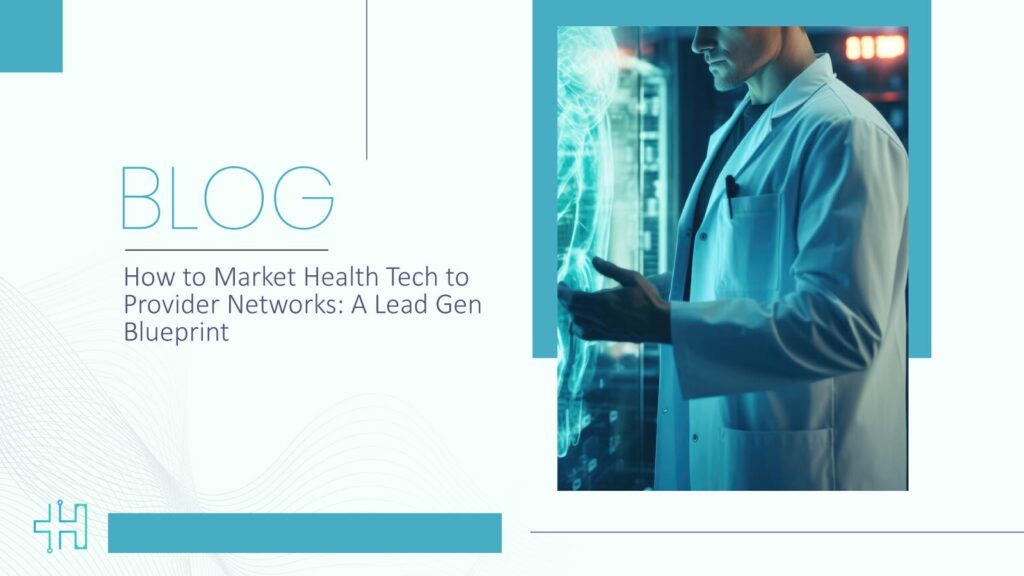The future of healthcare is interconnected, data-informed, and more digital, with provider networks at the center. For health tech firms, this is a golden moment to step forward and deliver genuine value.
So you’ve created a fantastic health tech solution. Now what? It’s time to get it in front of those who need it most. Yes, provider networks.
Breaking into provider networks with a health tech solution isn’t just about having a great product; it’s about understanding the ecosystem, knowing what decision-makers care about, and using data to build meaningful connections.
In this lead gen blueprint, we’ll break down what it takes to effectively market your health tech product to provider networks and generate qualified leads that convert.
About Provider Networks
Provider networks are the backbone of healthcare systems, linking insurers with physicians to facilitate that patients get the care they require. As per experts, 93% of healthcare marketers are getting ready to implement AI technologies, a major enabler for health tech marketing tactics. These innovations make it more critical to understand the intricacies of provider networks since the incorporation of AI in healthcare operations is increasing.
In-Network Providers: These are health providers and facilities that have negotiated discounted prices with the insurer. The patients pay less when they see in-network providers.
Out-of-Network Providers: These providers have no agreement with the insurance scheme. Their services are usually higher in price and sometimes not reimbursed at all.
As the healthcare IT market continues to expand (projected to reach $730 billion by 2029), provider networks will increasingly depend on cutting-edge technologies to optimize operations and enhance patient outcomes.
Know Your Audience Inside Out
Marketing always begins with knowing whom you’re communicating with. Are you addressing hospital systems, ACOs, outpatient clinics, or specialty providers? Each has its objectives, technology, and practices. By understanding these variations, you can connect in a manner that truly resonates with them.
Who is the Provider Network’s Audience?
Provider networks serve a wide ecosystem of stakeholders with various needs, goals, and challenges. From the patients seeking cheap, convenient care to the payers building cost-effective, high-value networks, each has a varying engagement with provider networks.
1. Patients / Health Plan Members
They are the ultimate users of provider networks. They are individuals covered under employer-sponsored, individual, or government health plans.
Who they are:
- Employees (through group health plans)
- Self-employed or individual policyholders.
- Dependents and family members.
2. HR & Benefits Teams / Employers
They make decisions, purchase group health plans, and oversee employee benefits.
Who they are:
- HR leaders and benefits managers
- CFOs or procurement officers
- Corporate wellness and employee experience teams
3. Healthcare Providers
These are network participants, such as doctors, clinics, hospitals, and specialists.
Who they are:
- Individual physicians and private practices
- Specialty clinics, mental health professionals
- Hospitals, urgent care, and telehealth platforms
- Accountable Care Organizations (ACOs)
4. Health Plans / Insurers
These are the provider network builders and managers.
Who they are:
- Commercial insurers
- Medicaid Managed Care Organizations (MCOs)
- Medicare Advantage Plans
- Health Maintenance Organizations (HMOs)
5. Regulators & Policy Makers
They are the governing entities that have charge of the way provider networks work.
Who they are:
- State Insurance Departments
- CMS (Centers for Medicare & Medicaid Services)
- State Health Exchanges
- Federal policy advisors and lawmakers.
Use Intent Data to Identify In-Market Prospects
Integrating AI-fueled data-driven campaigns is becoming increasingly popular among 93% of healthcare marketers who want to drive solution adoption and patient engagement.
Intent data provides you with a snapshot of actual buyer behavior, such as what content a prospect is viewing, what keywords they’re searching, what webinars they’re attending, and even which competitor tools they’re being compared against. These signals allow you to rank leads who are researching solutions such as yours.
Therefore, intent data isn’t guessing, but it’s a time and relevance shortcut. If used well, it lets you send targeted messages that engage prospects at the exact point in their buying journey.
Overcome Key Marketing Challenges
Marketing health tech products to provider networks presents excellent opportunities to advance your innovation and make a lasting impact. With the right approach and strategies, you can create meaningful connections and drive growth.
Here’s how to leverage the potential in this high-speed arena:
- Market Saturation: The health tech space is saturated. Differentiate by identifying what makes your solution unique and substantiate that with results.
- Changing Buyer Personas: With roles such as HR and clinical leaders constantly evolving, it’s crucial to adapt your messaging accordingly. Tracking shifts in buyer behavior is essential for staying ahead of industry changes.
- Data Privacy Regulations: Having your product compliant will assist you in gaining the trust of provider networks, particularly with the increasing demand for data privacy protection within the healthcare sector.
- Demonstrating ROI: Providers must experience concrete evidence of the technology they implement. Showing how your solution enhances efficiency, reduces costs, or increases outcomes is key to gaining traction. So, AI-powered solutions that demonstrate ROI are rapidly gaining popularity among healthcare markets.
- Staying in Sync with Industry Trends: The healthcare market is ever-changing. Hence, keeping up with trends and demonstrating thought leadership with your content will make you relevant and credible to provider networks.
Choose the Right Marketing Channels
Implement a multi-channel strategy that gets in front of stakeholders wherever they are, on touchpoints, and at varying stages of the buying journey, the content must resonate with provider networks and health tech marketers.
Focus your efforts on:
- Content Marketing: Develop case studies, whitepapers, and blogs that provide solutions to real-world challenges.
- Email Campaigns: Leverage segmentation and intent signals to send highly personalized emails.
- Social Media: Post insights, interact with others, and build credibility among health professionals.
- Webinars and Virtual Events: Highlight product features, include customer testimonials, and address industry trends.
- SEO: Tailor your content to important healthcare keywords to increase visibility when providers are actively searching.
Measure What Matters
In order to maximize your approach, you have to have a clear, unobstructed view of what works, what doesn’t, and where to double down. And that’s where key performance indicators (KPIs) come in. They are your map, leading each campaign, pitch, and pivot.
Here are the metrics that matter:
- Lead Generation: The number of qualified leads entering your funnel. Whether gated content, webinars, or intent data signals, monitoring lead volume enables you to gauge the reach and relevance of your campaigns.
- Conversion Rates: How many leads are turning into customers? Monitor conversion rates by stage, from initial interest to demo request, and from demo to deal closed. A well-converted funnel indicates that your message is resonating and your sales process is frictionless.
- Customer Acquisition Cost (CAC): Your CAC informs you of how much you’re spending to acquire each new customer. To derive it, take your total sales and marketing expenses and divide it by the number of new customers acquired during a specified time frame. Low CAC, coupled with high customer lifetime value (CLTV), suggests you’re playing the long game right.
- Return on Investment (ROI): In B2B health tech, ROI also encompasses intangible returns, like enhanced brand credibility or more strategic partnerships with healthcare systems. Nevertheless, the figures don’t lie, and measuring revenue against spend enables you to optimize where to invest the future budgets.
- Engagement Metrics: Monitor website traffic, content downloads, email open rates, and social media activity. These are the early indicators of your campaign’s “pulse checks.” Monitor:
- Website Traffic – Are more providers finding you?
- Content Downloads – What resources are getting attention?
- Email Open and Click Rates – Is your message landing?
- Social Media Activity – Are healthcare professionals interacting with your brand?
In Conclusion
The future of health tech marketing is precision, personalization, and partnership. As provider networks transform to accommodate the needs of contemporary care delivery, health tech firms have a golden chance to align their solutions with actual world needs.
By knowing your audience, leveraging the power of intent data, and measuring what matters, you can create lasting relationships that drive adoption and deliver impact.
So go ahead, build those data-driven campaigns, share stories that resonate, and meet providers where they are. The right message, to the right audience, at the right time can make all the difference.
FAQs
1. How can I effectively market my health tech solution to provider networks?
Marketing to provider networks requires a deep understanding of their unique needs and challenges. Tailor your messaging to highlight how your solution addresses specific pain points, such as improving patient outcomes or streamlining administrative processes. Utilize case studies and data-driven results to build credibility and demonstrate value.
2. What are the key challenges in marketing health tech to provider networks?
Some common challenges include navigating complex decision-making processes, ensuring compliance with healthcare regulations, and differentiating your product in a crowded market. Building trust through transparent communication and demonstrating a clear return on investment can help overcome these hurdles.
3. Which marketing channels are most effective for reaching provider networks?
A multi-channel approach is often the most effective. This can include content marketing (blogs, whitepapers), email campaigns, webinars, and social media engagement, particularly on professional platforms like LinkedIn. Tailor your strategy to where your target audience is most active and receptive.
4. How do I measure the success of my health tech marketing efforts?
Key performance indicators (KPIs) to monitor include lead generation numbers, conversion rates, customer acquisition costs, return on investment, and engagement metrics like website traffic and content downloads. Regularly analyzing these metrics can help refine your strategy and improve outcomes.
5. What role does intent data play in marketing to provider networks?
Intent data provides insights into potential customers’ online behaviors, indicating their interest in specific solutions. By analyzing this data, you can identify and prioritize prospects who are actively researching products like yours, allowing for more targeted and timely outreach.
Ready to Turn Insights into Action?
To participate in our interviews, please write to our HealthTech Media Room at sudipto@intentamplify.com






